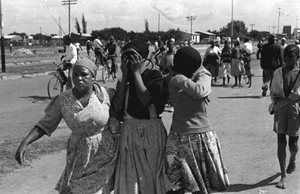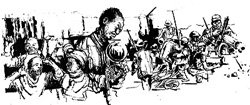Art in the state of siege
The Sharpeville Massacre was one of the most important turning points in the history of South Africa. It triggered a chain of events, from the banning of liberation organisations, the launch of the armed struggle, the internationalisation of South Africa’s Apartheid policies and the growing division between black and white South Africans.
The Liberation Struggle in South Africa from the 1960s to the 1990s gave rise to a number of schools of thought on the role of culture (art & literature) under a racially oppressive and authoritarian society. The debates ranged from the use of the arts as a weapon of the struggle to the establishment of community art centres as the building blocks of a new people-centred non-racial cultural practice, the democratisation and transformation of establishment spaces to the debate about looking at art as more than a space for political expression.
On the other hand, the dominant discourse amongst Whites was mainly dependent on their support or opposition to the Nationalist Party (NP) led government. Whites seemed to either accept the status quo, i.e. buying into the racial theories about people developing their own separated cultural practices, or they seemed to reject this crude racial discourse and oppose the state policies arguing that art should have an independent existence, with its own intrinsic values, that went beyond political party policies and addressed universal truths and the human condition.
There were also those who argued that artists could not deny the realities of living in a repressive society and their art should reflect on the injustices of that society as artists should be obliged to expose state repression. This group furthered their views in the 1980s and developed a radical critique of society, arguing that artists had an obligation to plan for the creation of a new “people or revolutionary culture”
Protest or Resistance Art?

Sharpeville Massacre 1960. Two grief-stricken young women being taken home after the one in the middle had viewed her husband's body twisted into a lifeless bulk by police gun fire, opposite the Sharpeville police station. (Photograph © BAHA)
Much of the art produced during Apartheid that in some way was critical of the state's racial, cultural and or political policies were labelled as either ‘Protest' or 'Resistance Art’. This term has been argued over by many commentators, historians and critics, but there is very little agreement on the usefulness of the label. The term reflected the great divide between well-meaning White academics and the Black and progressive artistic community.
The rewriting of our history and of art history in this case requires a critical understanding of the evolution and development of artistic movements. It also requires us to look at the subjective factors that serve as the key to the production of a particular body of work and to understand in what circumstances the work was produced, exhibited and circulated if at all.
One also needs to examine the State, its education and cultural policies, the relationship between the visual arts and other disciplines and last but not least trends and debates among artists within the liberation organisations and other groups opposed to the status quo.
By taking this approach we will notice, firstly that there was a range of ways in which artists responded to unfolding social and political events. Secondly that even at the height of repression artists used their work to bear witness and to reject their protests but there was intense debate amongst artists opposed to apartheid on ways of representing their reactions and opposition to the system.
We will explore how some artists who were active in or supported ‘the struggle’ choose not to produce work that served an overtly party political cause, but who nevertheless produced work that had a significant impact on their audience, work that clearly reflected their concerns about the impact of the norms and values of a society subjected to unjust and oppressive laws. There were also artists who did not belong to any ‘struggle’ organisation but they produced works that made powerful statements about the injustices of white minority rule.

Figure 2: Thami Mynele's art work
On the other hand, there were artists who openly sided with the opposition and produced works that were used to mobilise people. Some of these artists produced work that required a sophisticated understanding of the artists’ use of references to other works of art like Dumile Feni’s ‘African Guernica’ (figure 1). Other works were overtly political but were never exhibited because it would have led to prosecution. Then there was work produced by artists such as Thami Mynele (figure 2), Omar Badsha and others whose art advocated that art should serve a social and political purpose yet they produced work that went beyond the overtly political.
In this feature, we examine work by artists that cover the different schools of thought. By examining their contributions and writing their biographies we will try to prove that while the term resistance and protest art have relevance in describing a particular genre, the term implies a much more complex phenomenon.
Our list of artists’ biographies and resources is not complete and will grow as this project and the discourse around it grows. Please feel free suggest material by clicking the contribute tab.